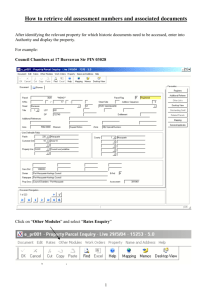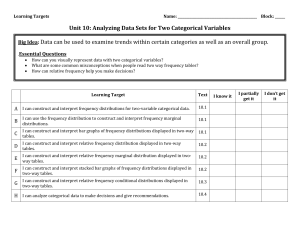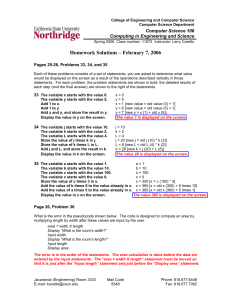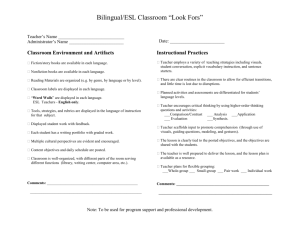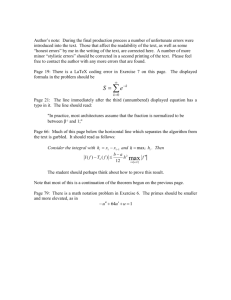Automatic Properties Adjusting Method using User Operations for
advertisement
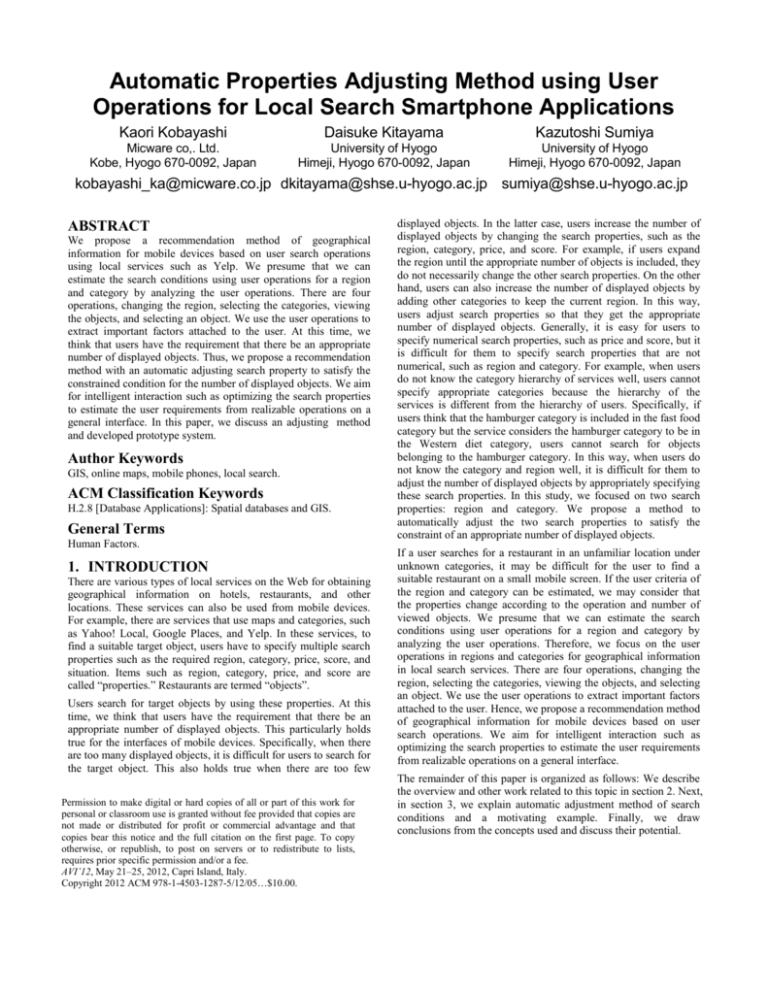
Automatic Properties Adjusting Method using User Operations for Local Search Smartphone Applications Kaori Kobayashi Daisuke Kitayama Kazutoshi Sumiya Micware co,. Ltd. Kobe, Hyogo 670-0092, Japan University of Hyogo Himeji, Hyogo 670-0092, Japan University of Hyogo Himeji, Hyogo 670-0092, Japan kobayashi_ka@micware.co.jp dkitayama@shse.u-hyogo.ac.jp sumiya@shse.u-hyogo.ac.jp ABSTRACT We propose a recommendation method of geographical information for mobile devices based on user search operations using local services such as Yelp. We presume that we can estimate the search conditions using user operations for a region and category by analyzing the user operations. There are four operations, changing the region, selecting the categories, viewing the objects, and selecting an object. We use the user operations to extract important factors attached to the user. At this time, we think that users have the requirement that there be an appropriate number of displayed objects. Thus, we propose a recommendation method with an automatic adjusting search property to satisfy the constrained condition for the number of displayed objects. We aim for intelligent interaction such as optimizing the search properties to estimate the user requirements from realizable operations on a general interface. In this paper, we discuss an adjusting method and developed prototype system. Author Keywords GIS, online maps, mobile phones, local search. ACM Classification Keywords H.2.8 [Database Applications]: Spatial databases and GIS. General Terms Human Factors. 1. INTRODUCTION There are various types of local services on the Web for obtaining geographical information on hotels, restaurants, and other locations. These services can also be used from mobile devices. For example, there are services that use maps and categories, such as Yahoo! Local, Google Places, and Yelp. In these services, to find a suitable target object, users have to specify multiple search properties such as the required region, category, price, score, and situation. Items such as region, category, price, and score are called “properties.” Restaurants are termed “objects”. Users search for target objects by using these properties. At this time, we think that users have the requirement that there be an appropriate number of displayed objects. This particularly holds true for the interfaces of mobile devices. Specifically, when there are too many displayed objects, it is difficult for users to search for the target object. This also holds true when there are too few Permission to make digital or hard copies of all or part of this work for personal or classroom use is granted without fee provided that copies are not made or distributed for profit or commercial advantage and that copies bear this notice and the full citation on the first page. To copy otherwise, or republish, to post on servers or to redistribute to lists, requires prior specific permission and/or a fee. AVI’12, May 21–25, 2012, Capri Island, Italy. Copyright 2012 ACM 978-1-4503-1287-5/12/05…$10.00. displayed objects. In the latter case, users increase the number of displayed objects by changing the search properties, such as the region, category, price, and score. For example, if users expand the region until the appropriate number of objects is included, they do not necessarily change the other search properties. On the other hand, users can also increase the number of displayed objects by adding other categories to keep the current region. In this way, users adjust search properties so that they get the appropriate number of displayed objects. Generally, it is easy for users to specify numerical search properties, such as price and score, but it is difficult for them to specify search properties that are not numerical, such as region and category. For example, when users do not know the category hierarchy of services well, users cannot specify appropriate categories because the hierarchy of the services is different from the hierarchy of users. Specifically, if users think that the hamburger category is included in the fast food category but the service considers the hamburger category to be in the Western diet category, users cannot search for objects belonging to the hamburger category. In this way, when users do not know the category and region well, it is difficult for them to adjust the number of displayed objects by appropriately specifying these search properties. In this study, we focused on two search properties: region and category. We propose a method to automatically adjust the two search properties to satisfy the constraint of an appropriate number of displayed objects. If a user searches for a restaurant in an unfamiliar location under unknown categories, it may be difficult for the user to find a suitable restaurant on a small mobile screen. If the user criteria of the region and category can be estimated, we may consider that the properties change according to the operation and number of viewed objects. We presume that we can estimate the search conditions using user operations for a region and category by analyzing the user operations. Therefore, we focus on the user operations in regions and categories for geographical information in local search services. There are four operations, changing the region, selecting the categories, viewing the objects, and selecting an object. We use the user operations to extract important factors attached to the user. Hence, we propose a recommendation method of geographical information for mobile devices based on user search operations. We aim for intelligent interaction such as optimizing the search properties to estimate the user requirements from realizable operations on a general interface. The remainder of this paper is organized as follows: We describe the overview and other work related to this topic in section 2. Next, in section 3, we explain automatic adjustment method of search conditions and a motivating example. Finally, we draw conclusions from the concepts used and discuss their potential. 2. AUTOMATIC ADJUSTMENT METHOD OF SEARCH CONDITIONS 2.1 Overview First, we describe the details of the user operation of the proposed mobile recommender system. The user operates three types of content: online maps, category hierarchy, and detailed information of the geographical objects. Generally, there are three operations: changing regions, selecting categories, and checking objects. There are two operations for checking objects: viewing objects and selecting objects. Objects can belong to multiple categories. For example, McDonalds belongs to the categories “Fast food,” “Sandwich,” and “Cafe”. In this way, users can explicitly set the search properties for the regions and categories. In our study, we adjust the user requirements using the search property, search condition, and constrained condition. The search property of a region is the search area such as “San Francisco.” In contrast, the search property of a category is a search category such as “Fast Food.” Here, the user can search for target restaurants using their selected categories and region. A search condition consists of the degree of strictness for the criteria of a region and categories. There are two kinds of search criteria, strong and weak. Constrained conditions have a preset filter such as an upper price limit, or device constraints such as the number of displayed objects depending on the screen size. Therefore, a constrained condition can always be satisfied by adjusting the search properties. Interactive operations 1. Receiving user operations 2. Analyzing user operations • Regional factor • Categorical factor • Objective factor Constraints Condition • Presetting filter • Device constraints Regional condition Categorical condition 3. Estimating search condition 2.2 Related work Toda et al. [6] proposed a ranking method considering the proximity between the name of a location and the keywords associated with the keywords of the query. In this paper, we focus on recommending geographical information using the dynamic intensity of the user criteria during local search operations. Most of this research is related to information retrieval using user preferences. Martinez et al. [3] proposed a restaurant recommender system that hybridizes the collaborative knowledgebased system, REJA, which utilizes user preferences and creates profiles. These studies are similar to our attempt to relate geographical information with a user's static information. However, based on the operation of the user, we recommend object optimized by estimating the user’s search criteria. Aula et al. [1] analyzed the user’s behaviors when Web-search retrieval does not perform well. They conduct an additional query and natural language behaviors when a user cannot search for information effectively. In a local search, adding categories and scaling down the regions are considered as behaviors. In conventional studies, the number of displayed objects from local services on mobile devices is controlled by an object score and the distance from the center position of the map [2, 4]. However, users have to specify the search criteria to manually control the number of displayed objects. Nowadays, conventional services can only display objects by setting the search criteria as per the user’s requirement. However, important factors in the retrieved information may change after the user’s operations on the displayed regions and the objects belonging to the selected categories. Therefore, our system extracts the intensity of a user’s search criteria from the user’s map operations and category selection history. 3. ANALYZING USER OPERATIONS Extraction of regional and categorical factors Next, we describe how we detect the user criteria of a region. We consider that the user has certain criteria when searching in a certain region. We define the regional factors, as these criteria can be detected by the map operations. 3 5 5 4 4 3 4. Adjusting search properties using search condition 2 Adjusted region and categories 2 Next, we describe the process used in our system (see Figure. 1). First, our system extracts the user operations. Second, the system analyzes the user operations and extracts the operation factors. Third, we estimate the search conditions from the user operations. Finally, the system determines the display control based on the search conditions, and then recommends geographical information. In this paper, we set the number of displayed objects to within a certain range as constrained conditions because users may find it hard to obtain relevant objects when there are too many or too few displayed objects. Thus, we developed an adding and reducing function for the number of displayed objects based on the search condition of the regions and categories. For example, if the state of a region has strong criteria based on the user preferences, we add/reduce objects using categories. In this way, we can recommend suitable objects for an unfamiliar area and categories. 1 1 Figure 1: system architecture Regional factor is ON Regional factor is OFF Figure 2: Determining the regional factor When a user operates a map several times and the regions selected frequently overlap, we consider that the user wants to search in this overlapping region (see Figure. 2). At this time, we detect regional factors as the user’s regional criteria. On the other hand, when a user operates a map several times, and there are few overlapped regions, we consider that this operation is for moving to a new area. In this case, the regional factor is not considered a regional criterion. Where n is the maximum number of regional histories, α is the threshold for the number of overlapping regions, R is the region, and Rs is a queue of the region history. The length faction returns a number of Rs elements. This algorithm works whenever the user operates a map. We count the number of overlaps of the currently displayed region and previously displayed region. If the number of overlaps is more than the threshold α, we detect the strong criteria for that region. The same concept applies to the category. Extraction of objective factor Object selection means that the user wants to search around the location of a selected object and is interested in the selected object’s category. We consider that user’s criteria have changed based on the state of the object selection: selected object, viewed object, and shown object. Therefore, we define the three types of objective factors as SELECT, VIEW, and NONE. A selected object has both strong region and category criteria. The user selects this object based on its position and information. We define SELECT as including at least one selected object in the current region and selected categories. A viewed object has strong region criteria, however the categorical criteria are weak. At this time, the user selects this object from the map, and does not select it from the object information. In other words, the user agrees with the object’s location, and disagrees with its information. We define VIEW as including at least one viewed object in the current region and selected categories without selected objects. A shown object has no criteria beyond the current region and selected categories. We define NONE as not including any selected or viewed objects in the current region and selected categories. 4. RECOMMENDATION USING SEARCH CONDITIONS 4.1 Estimation of search conditions We estimate the user’s search condition using the regional, categorical, and objective factors. The user’s search condition consists of regional and categorical search conditions. The regional search condition is the degree of criteria for the current region. If the regional search condition is high, the user wants to search for geographical objects in the current region. By contrast, if the regional search condition is low, the user does not want to search in the current region necessarily. Similarly, the categorical search condition is the degree of criteria for the current categories. If the categorical search condition is high, the user wants to search for geographical objects that are included in the current categories. By contrast, if the categorical search condition is low, the user does not search using current categories necessarily. Under a constraint such as the number of displayed objects on a mobile device, the search condition is a trade-off problem. We define this constraint as the number of displayed objects being between γ and δ. We use both values of the regional and categorical search conditions for this trade-off. We translate from regional, categorical, and objective factors to values of regional search conditions (R_value) and categorical search conditions (C_value) using the translation rule shown in Table 1. In Table 1, if the factor has a strong criterion, this value is 1. On the other hand, when the factor has a weak criterion, this value is 1. If the factor is not related to the search condition, this value is 0. Finally, we add each value from each factor as the regional and categorical search conditions. Therefore, the value of the search condition is between 2 and -2. A value of 2 indicates the strongest criterion, and in such case we consider that the user does not want to change the search property. We describe how we adjust the individual search conditions using the changing region function and changing category function. We give an overview of the adjustment strategy in the following paragraph. We adjust the search property when we detect a trigger condition or operation. Trigger conditions are defined as follows. 1) the regional factor is ON, 2) the categorical factor is ON, or 3) the objective factor is SELECT or VIEW. Trigger operations are defined by the number of shown objects after an operation as follows. 1) The number of shown objects is over threshold γ, or 2) the number of shown objects is under threshold δ. Table 1: Translating rule from each factor to each search condition Factors Regional factor Categorical factor Objective factor R_value C_value ON 1 0 OFF -1 0 ON 0 1 -1 OFF 0 SELECT 1 1 VIEW 1 -1 NONE 0 0 Algorithm 1 Recommendation using Search Conditions while Number of shown objects > γ or Number of shown object < δ do D ←R_value – C_value if D = 0 then Do changing region algorithm and Do changing category algorithm else if D > 0 then if Count = D then Do changing region algorithm, Count ← 0 else Do changing category algorithm, Count ←Count + 1 end if else if D < 0 then if (Count x –1) = D then Do changing category algorithm, Count ← 0 else Do changing region algorithm, Count ←Count + 1 end if end if end while We adjust the search property using the ratio between each search condition. If the difference between R_value and C_value is 0, we adjust the search properties using the changing region function and changing category function together. When R_value is n times larger than C_value, we adjust the search properties using the changing category function n times and the changing region function once. On the other hand, when the R_value is n times smaller than C_value, we also adjust the search properties using the changing region function n times and the changing category function once. 4.2 Optimizing region and category using search conditions Next, we explain how we adjust the search property of a region. A map can add the number of shown geographical objects by widening the display region, or reduce the number of shown geographical objects by narrowing this region. If the number of shown objects is over the threshold γ, we narrow the display Figure 3: An example of recommendation by Mariposa region of the map by one level of scale. If the number of shown objects is under threshold δ, we widen the display region of the map by one level of scale. We can add or reduce the number of objects until it is between γ and δ by repeating this process. Consequently, we adjust the search property of a region using the following algorithm, where the length function returns the number of currently shown objects, O. Categories because the conventional system supports no relevant options. Therefore, our system approximates the user requirements based on the constrained condition of displayed numbers by estimating the user’s search condition. In this case, the system adds a restaurant belonging to categories similar to “fast food” automatically. Additionally, the system adds restaurants to offer an appropriate number of displayed objects. 5. CONCLUSION Categories Restaurants Restaurants Cafes Cafes Hot Dogs Hot Dogs Fast Food Fast Food Sandwiches Sandwiches Japanese Japanese Sushi Bars Sushi Bars ... ... Food Food Nightlife Nightlife ... ... Figure 4: An example of changing category function Next, we explain how we adjust the search property of a category. We adjust a category by adding a similar category or removing one dissimilar to the currently selected category (see Figure 4). If the categories include a lot of similar objects, the categories are considered similar. When the number of shown objects is over threshold γ, we remove those objects that are in the category that is most dissimilar with selected category. In other words, we add this category to the list of excluded categories. When the number of shown objects is under threshold δ, we add the category that is most similar with the currently selected category. We can add or reduce the number of objects until the number shown is between γ and δ by repeating this process. We provide some typical examples by our system called Mariposa (see Figure 3). When a user wants to search for restaurants for a light meal near a certain station, the user will select a category such as “light meal.” However, if there are few restaurants belonging to this category in the display region, the user can add other categories similar to “light meal” because the displayed results were not satisfactory. If the displayed results do not change significantly, however, it may be difficult for the user to search for target restaurants for a light meal if the user does not know other similar categories. In this case, the user cannot search for restaurants well, which is adapted into the user’s search condition In this paper, we presented a geographical information recommendation method for mobile devices based on user search operations. We focused on adjusting the search property automatically from the user’s search conditions and enabling intelligent interaction between realizable user operations and the general interface. In this way, we solved the problem of the constrained condition for the number of displayed objects on mobile interfaces. In future work, we have to improve the recommendation algorithm for objects and evaluate the comfort of the operation and interface. 6. REFERENCES [1] A. Aula, R. M. Khan and Z. Guan. How does search behavior change as search becomes more difficult?, Proceedings of the 28th international conference on Human factors in computing systems, pp.35–44, 2010. [2] M. Cho, B. H. Kim, D. K. Jeong, Y-G. Shin and J. Seo. Dynamic query interface for spatial proximity query with degree-of-interest varied by distance to query point. In Proceedings of the 28th international conference on Human factors in computing systems, pp.693–702, 2010. [3] L. Martinez, R. M. Rodriguez and M. Espinilla. A Georeferenced Hybrid Recommender System for Restaurants. In Proceedings of the 2008 IEEE/WIC/ACM International Conference on Web Intelligence and International Conference on Intelligent Agent Technology Workshops, pp.187–190, 2009. [4] D. Mountain and A. MacFarlane: Geographic information retrieval in a mobile environment: Evaluating the needs of mobile individuals. Journal of Information Science, vol.33, no.5, pp.515–530, 2007. [5] H. Toda, N. Yasuda, Y. Matsuura and R. Kataoka. Geographic information retrieval to suit immediate surroundings. In Proceedings of the 17th ACM SIGSPATIAL International Conference on Advances in Geographic Information Systems, Seattle, Washington, pp.452–455, 2009.
